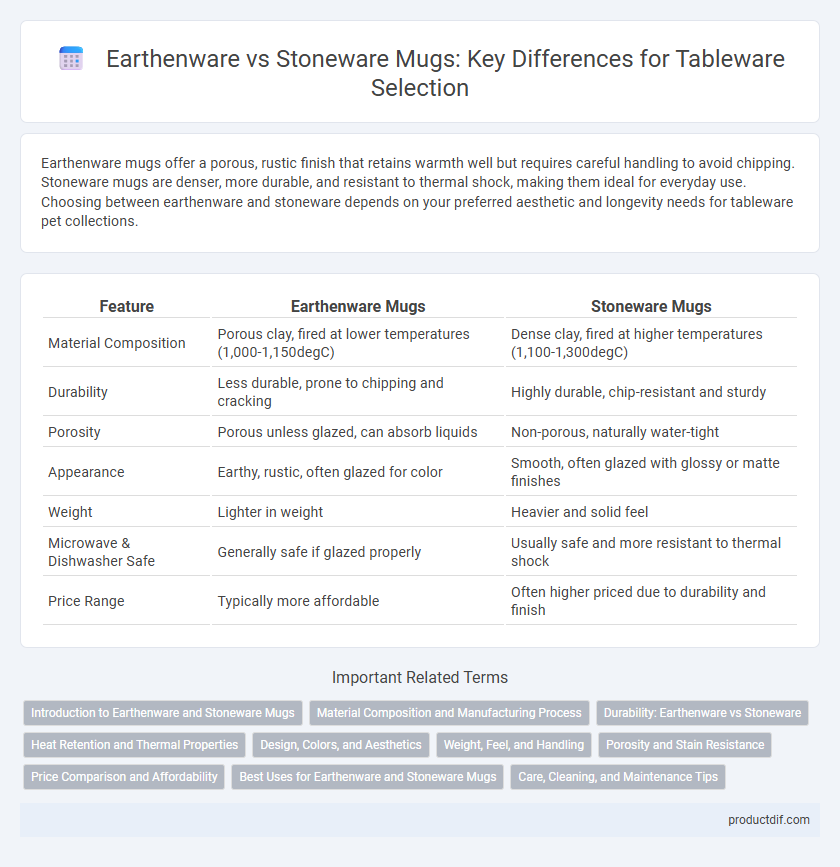Earthenware mugs offer a porous, rustic finish that retains warmth well but requires careful handling to avoid chipping. Stoneware mugs are denser, more durable, and resistant to thermal shock, making them ideal for everyday use. Choosing between earthenware and stoneware depends on your preferred aesthetic and longevity needs for tableware pet collections.
Table of Comparison
| Feature | Earthenware Mugs | Stoneware Mugs |
|---|---|---|
| Material Composition | Porous clay, fired at lower temperatures (1,000-1,150degC) | Dense clay, fired at higher temperatures (1,100-1,300degC) |
| Durability | Less durable, prone to chipping and cracking | Highly durable, chip-resistant and sturdy |
| Porosity | Porous unless glazed, can absorb liquids | Non-porous, naturally water-tight |
| Appearance | Earthy, rustic, often glazed for color | Smooth, often glazed with glossy or matte finishes |
| Weight | Lighter in weight | Heavier and solid feel |
| Microwave & Dishwasher Safe | Generally safe if glazed properly | Usually safe and more resistant to thermal shock |
| Price Range | Typically more affordable | Often higher priced due to durability and finish |
Introduction to Earthenware and Stoneware Mugs
Earthenware mugs are crafted from porous clay fired at lower temperatures, resulting in a rustic, lightweight texture with a natural, earthy appearance. Stoneware mugs are made from denser clay fired at higher temperatures, offering greater durability, non-porous surfaces, and enhanced resistance to chipping and thermal shock. Both materials provide unique aesthetic qualities, but stoneware's vitrified finish ensures longer-lasting, dishwasher-safe tableware ideal for everyday use.
Material Composition and Manufacturing Process
Earthenware mugs are made from natural clay fired at lower temperatures between 1,000 and 1,150degC, resulting in a porous and less durable material often glazed to prevent leaks. Stoneware mugs consist of denser clay mixtures fired at higher temperatures ranging from 1,200 to 1,300degC, producing a non-porous, vitrified, and more resilient surface. The manufacturing process of stoneware involves longer firing times and higher heat, enhancing strength and chip resistance compared to the softer, more fragile earthenware.
Durability: Earthenware vs Stoneware
Stoneware mugs exhibit superior durability compared to earthenware mugs due to their higher firing temperature, which creates a denser, non-porous structure resistant to chipping and cracking. Earthenware mugs, fired at lower temperatures, are more porous and fragile, requiring careful handling to avoid damage. The robustness of stoneware makes it ideal for everyday use, while earthenware suits decorative or occasional purposes.
Heat Retention and Thermal Properties
Earthenware mugs typically have lower heat retention due to their porous nature, which allows heat to escape more quickly compared to stoneware mugs. Stoneware mugs are denser and fired at higher temperatures, resulting in superior thermal insulation that keeps beverages warmer for longer periods. The enhanced thermal properties of stoneware make it ideal for maintaining the temperature of hot drinks like coffee and tea.
Design, Colors, and Aesthetics
Earthenware mugs showcase a rustic charm with matte finishes and earthy tones like terracotta, ochre, and muted greens, emphasizing a handcrafted, organic aesthetic ideal for cozy settings. Stoneware mugs offer a more durable build with smooth, often glossy surfaces, featuring a broader color palette that includes deep blues, grays, and vibrant glazes, lending a refined yet earthy elegance to modern table settings. Both materials enhance tableware design but cater to different stylistic preferences: earthenware favors warmth and tradition, while stoneware balances durability with contemporary sophistication.
Weight, Feel, and Handling
Earthenware mugs are lighter and have a more porous texture, giving them a rustic feel that is warm and organic in hand. Stoneware mugs are heavier, denser, and smoother, creating a solid, substantial grip that feels durable and refined. Both materials offer distinct tactile experiences, with earthenware providing a more delicate touch and stoneware delivering enhanced sturdiness for everyday use.
Porosity and Stain Resistance
Earthenware mugs have higher porosity compared to stoneware mugs, making them more prone to absorbing liquids and stains over time. Stoneware mugs are fired at higher temperatures, resulting in a denser, less porous surface that offers superior stain resistance and durability. This makes stoneware mugs a more practical choice for everyday use where stain prevention is a priority.
Price Comparison and Affordability
Earthenware mugs generally cost less than stoneware mugs due to lower firing temperatures and simpler production processes, making them more affordable for everyday use. Stoneware mugs, fired at higher temperatures, offer increased durability but come with a higher price point reflecting enhanced strength and finish quality. Budget-conscious buyers favor earthenware for cost savings, while those prioritizing longevity often invest in pricier stoneware options.
Best Uses for Earthenware and Stoneware Mugs
Earthenware mugs excel in casual settings and are ideal for serving hot beverages like tea and coffee due to their porous nature that retains warmth but requires gentle handling. Stoneware mugs are best suited for everyday use, offering durability and resistance to chipping, making them perfect for both hot and cold drinks in busy kitchens or cafes. Their dense, non-porous finish also ensures easy cleaning and long-lasting appeal for frequent use.
Care, Cleaning, and Maintenance Tips
Earthenware mugs require gentle hand washing with mild soap to prevent porous surface damage and should be air-dried to avoid moisture retention, while stoneware mugs offer greater durability and are often dishwasher-safe due to their non-porous glaze. Avoid using abrasive scrubbers on both earthenware and stoneware to maintain their glaze integrity and prevent chipping. Regular inspection for cracks or chips is essential to ensure safety and longevity for both types of mugs.
Earthenware Mugs vs Stoneware Mugs Infographic

 productdif.com
productdif.com